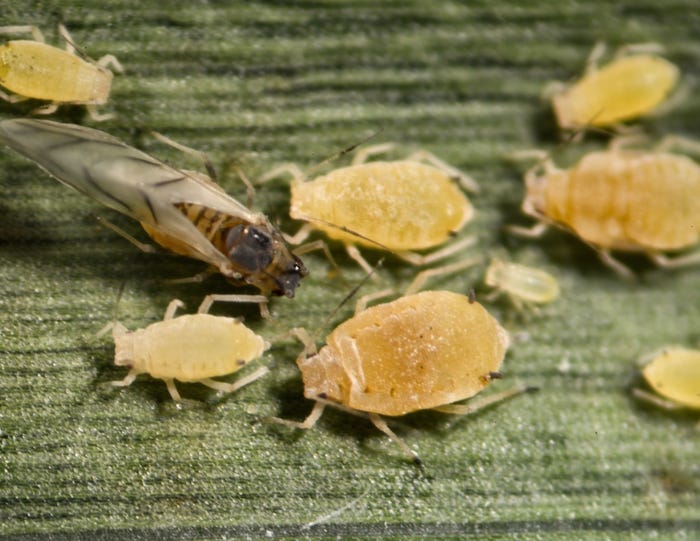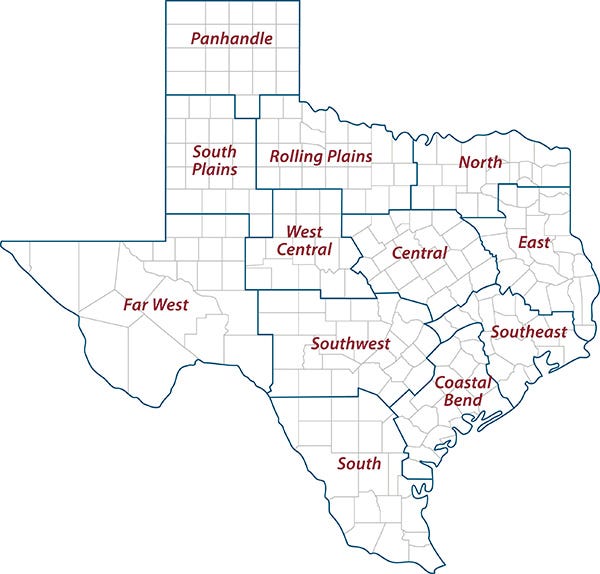
Sugarcane aphids are not “as big a deal as they were years ago,” says Pat Porter, Texas A&M AgriLife Extension entomologist, Lubbock. The creation of resistant hybrid sorghum varieties, vigilant monitoring and spray applications are credited for keeping numbers in check as they migrate, he said.
In 2013, sugarcane aphids devastated sorghum fields after their emergence in fields around Beaumont. By 2015, they made their way to the Texas Plains, and the results were catastrophic for sorghum producers.

Producers in the Rio Grande Valley lost $31 million to the pest in 2015, according to an AgriLife Extension study that also showed producers who utilized recommended scouting and spraying regimens once the pest neared thresholds avoided $35 million in potential losses.
Since then, sugarcane aphids' effect on Texas’ sorghum production has waned, and Porter said this season has shown numbers continue to decline.
“There’s so many fewer aphids coming up from South Texas,” he said. “The resistant hybrids are the No. 1 factor, and then you have producers in South and Central Texas who are on top of their numbers and really decreasing the migratory populations.”
Porter said some producers along the Gulf Coast sprayed their fields, but on the High Plains, where producers report sugarcane aphid activity, he suspects they may be manageable without applications if beneficial insect populations are well-established.
Forage sorghum
Forage sorghum, however, continues to be affected by sugarcane aphids because there are very few aphid-tolerant forage sorghum hybrids. It is also planted more densely and grows taller than grain fields. Those factors make spray applications less effective and forage fields more susceptible to significant infestations.
Jourdan Bell, AgriLife Extension agronomist, Amarillo, said forage sorghum has become an increasingly important silage option for beef cattle and dairy producers in the region. It’s a drought-tolerant alternative to corn silage and can withstand intermittent periods of in-season drought stress without losing quality as quickly as corn.
Texas A&M AgriLife Research efforts show that timely identification and management help reduce sugarcane aphid effects on forage yields and quality.
Untreated test plots experienced 33%-44% yield losses and reduction in quality as a forage, Bell said. Data showed relative feed quality was reduced by as much as 50% under heavy sugarcane aphid infestations.
“With the arrival of sugarcane aphids on the Texas High Plains, we have seen many forage sorghum fields lost to sugarcane aphid feeding as well as yield and quality reductions,” she said. “It is important that producers and consultants are scouting their forage sorghum fields and applying timely insecticide application to maintain yield and quality.”
AgriLife Extension district reporters compiled the following summaries:

A map of the 12 Texas A&M AgriLife Extension districts.
CENTRAL
Extreme heat and drought conditions continued to hurt all crops, pastures and rangelands. Early planted corn was mostly harvested for silage, and a second crop was planted. Corn harvest was just getting underway in other areas. Corn was drying down quickly in the heat. Nearly all areas reported crops were in fair to good condition. Irrigation was running at maximum capacity. Pastures were starting to show stress due to extreme heat. The arid conditions dried down some wet and flooded areas along the Navasota River and Lake Mexia. Producers made some hay, and pastures were green and lush for this time of year. Forage growth slowed in most areas due to heat and lack of moisture. Rain was in the forecast. All counties reported short soil moisture conditions.
ROLLING PLAINS
Temperatures were hot, and conditions remained dry. Irrigated crops were in good condition while dryland fields needed moisture. The cotton crops were continuing to progress. Rangeland and pastures were showing stress from dry weather.
COASTAL BEND
Scattered showers occurred in some areas, while other areas remained completely dry. Temperatures were beyond 100 degrees in some areas. Dry weather was a positive for ongoing corn and sorghum harvests. Reported yields ranged from fair to above expectations. Cotton continued to progress, and some was already being defoliated. Cotton harvest should begin within the next 10 days. Rice was heading out. Some hay pastures were being cut and baled. Rangeland and pasture conditions were on the dry side. Livestock were in good condition, with supplemental feeding increasing and likely will pick up drastically as pastures continued to dry.
EAST
Conditions were hot and dry. More rainfall was needed. Hay production continued. Pasture and rangeland conditions were good. Subsoil and topsoil conditions were adequate. Many producers treated for armyworms and grasshoppers. Good quality peaches and blueberries were harvested. Watermelons continued to be harvested. Cattle were in good condition. Flies remained a problem. Wild pig activity continued in pastures and vegetable crops.
SOUTH PLAINS
Very dry conditions continued across the district with record temperatures in the triple digits. Irrigated cotton was doing well and starting to square. Flea hoppers were found in several areas. Irrigated corn was silking, but spider mites were found in some fields. Cattle producers were providing supplemental feed as grazing was not enough to sustain cattle. Cattle were still in good condition.
PANHANDLE
Scattered rains occurred across the district, but heat and drought conditions persisted. Northern areas reported short to adequate topsoil moisture and short to adequate subsoil moisture. Central and southern areas reported very short subsoil and topsoil moisture levels. Pasture and rangeland conditions were fair to very poor. Corn and cotton were reported as good to fair. Cotton was reported as good to fair. Sorghum conditions were poor to fair. Peanuts were in poor to fair condition. Producers were making decisions about abandoning some crops. Insect pressures were quite low due to dry and hot conditions.
NORTH
Topsoil moisture levels were mostly short to adequate. Fields started to dry out quickly without rain as temperatures exceeded 100 degrees. Late-planted sorghum was coming in, and corn looked good. Soybeans and cotton were doing well. There were reports of chinch bugs in some Sudan fields. Numerous grasshoppers were reported in some fields.
FAR WEST
Daytime temperature highs reached 114 degrees with a nighttime low of 68 degrees. Trace amounts of rain were reported. Winds of 25 mph and gusts up to 35 mph were reported. Upland cotton was stunted, but irrigated cotton started setting bolls. El Paso County cotton reported both Upland and Pima looked excellent. Most other cotton showed solid squaring. Livestock continued to hold good body conditions. Producers were feeding heifers retained as replacements. High temperatures and lack of rain caused concern for wildfires and low water supplies for livestock. Alfalfa farmers reported a very productive year. Most were on their third cutting for the season. Pecan orchards also looked very good with very little pest pressure reported. Honey bees were active.
WEST CENTRAL
The district needed rain. Very hot and dry conditions persisted. Rangeland and pasture conditions declined rapidly due to drought stress. Crop conditions were declining as well. Cotton was in mostly fair condition. Grain and forage sorghum showed drought stress. Some hay was baled with below average yields reported. Some wildfires occurred, and fire dangers were increasing. Livestock were in fair condition.
SOUTHEAST
Conditions were very dry. A good rain was reported in Chambers County and was soaked up immediately. Multiple rain events were in the forecast from possible tropical disturbances. Forage grass quality was holding on despite the hot and dry conditions, but some pastures were beginning to brown. Pasture ratings ranged from poor to excellent. Vegetable gardens needed regular irrigation to maintain quality. Rice continued to progress. The first rice was harvested. Soil moisture levels ranged from adequate to very short.
SOUTHWEST
Hot and dry conditions continued and led to further decline in pastures and rangelands. Sorghum harvest was in full swing with average yields reported. Corn harvest was underway or about to begin in most areas. Cotton fields looked good. Caldwell County reported only a small percentage of cotton was starting to set bolls. Livestock conditions remained fair to good. Cattle prices looked decent, and sheep and goat markets remained steady. Supplemental feeding was helping livestock and wildlife.
SOUTH
The district reported hot and dry weather conditions with adequate to very short soil moisture levels. Several counties reported no rain and temperatures at or above 100 degrees. Live Oak County reported daytime high temperatures of 105-110 degrees for more than a week. Webb County reported light rainfall. Rainfall was in the forecast. Corn harvest was in full swing and nearing completion in some areas. The cotton crop progressed well but was stressing and cutting out in some areas; leaves were changing colors or falling, and bolls were opening. Irrigated cotton looked good. Peanut fields were in the pegging stage and being irrigated. Watermelon harvest continued. Pasture and rangeland conditions continued to decline due to excessive heat and dry weather. Producers were jumping from harvesting grain sorghum to corn because crop progress was so inconsistent. Livestock were spending less time grazing and more time in the shade or in livestock ponds to cool off. Calf weights and body scores in adults were declining as a result. Hay baling season was wrapping up as the last pastures were burning up quickly due to hot, dry winds. Many pastures were overgrazed, and forages were deteriorating. Irrigated crops like watermelons and cantaloupes and Coastal Bermuda grass were performing well. Ranchers and deer breeders were supplementing their livestock and wildlife, including providing water in some areas. Hay producers continued to store as much hay as possible, but bales were selling quickly. Round bale prices were $65-$85 with square bales going for $7-$10 each. Cattle prices remained steady.
Source: is AgriLife TODAY, which is solely responsible for the information provided and is wholly owned by the source. Informa Business Media and all its subsidiaries are not responsible for any of the content contained in this information asset.
About the Author(s)
You May Also Like




